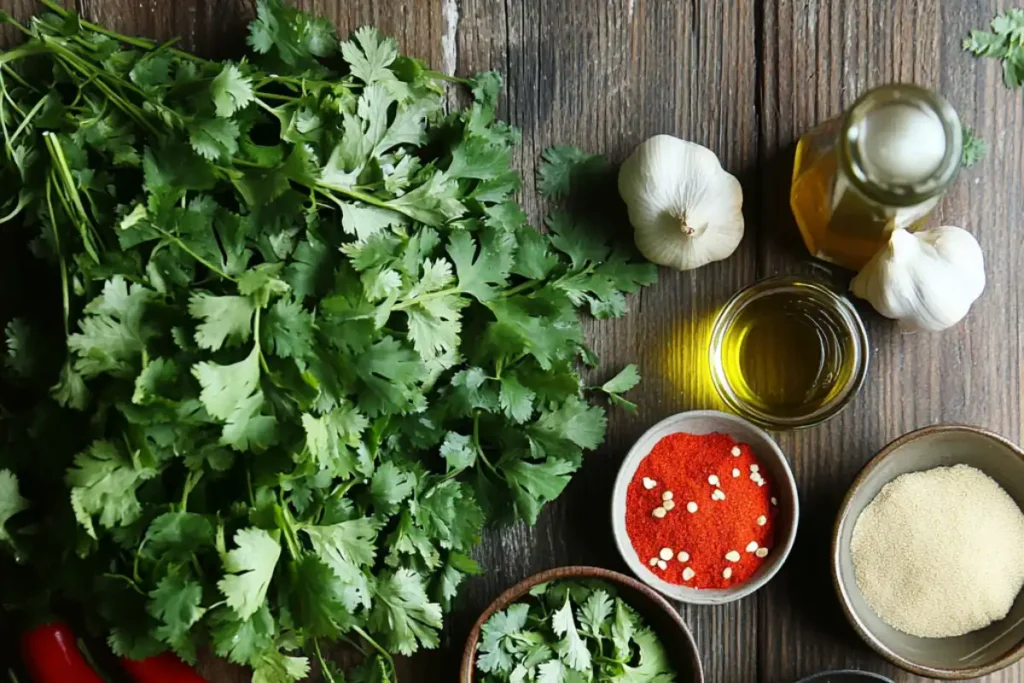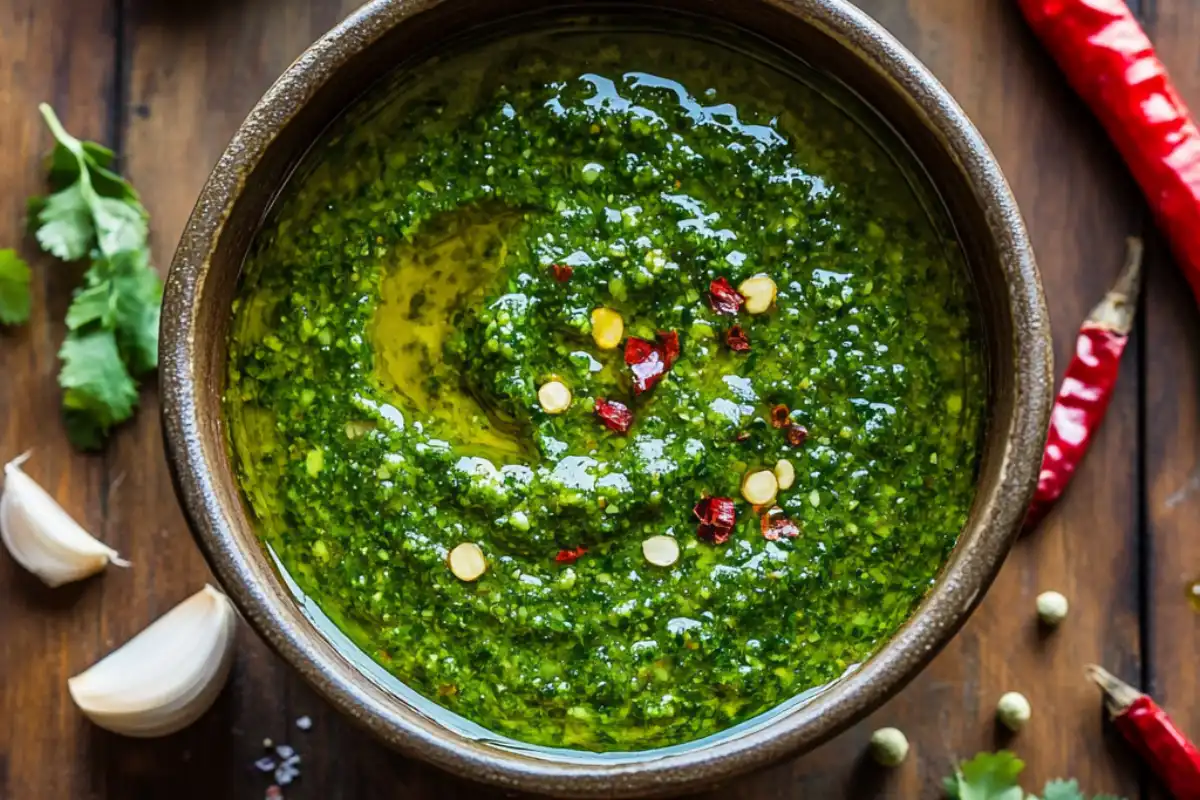Skhug, also known as zhug or shug, is a fiery and aromatic sauce that originates from Yemen and has become a staple condiment in Middle Eastern cuisine. Packed with fresh herbs and chilies, Skhug brings a vibrant heat and burst of flavor to a wide range of dishes. But what does Skhug taste like, and what makes it so unique?
In this comprehensive article, we’ll explore what does Skhug taste like, the role of its ingredients, how it compares to other spicy sauces, and how its taste can vary depending on the preparation. By the end, you’ll have a deep understanding of what makes this sauce a must-try for spice lovers.
Table of Contents
What is Skhug?
Skhug is a traditional Middle Eastern hot sauce primarily made from fresh cilantro, parsley, chilies, garlic, and olive oil. Depending on the type of chilies used, it takes on a vibrant green or red color. The sauce’s herbal base, combined with the heat from the chilies, creates a flavor that is as refreshing as it is spicy.
Unlike other hot sauces, what does Skhug taste like is determined by its mix of fresh herbs, which gives it a bright and tangy taste that balances out the spiciness. Skhug’s versatility allows it to be used as a condiment, dip, or marinade, making it a perfect addition to grilled meats, vegetables, or even sandwiches.
What Does Skhug Taste Like? Exploring Its Flavor Profile

Skhug’s taste is defined by a combination of fresh herbs, chilies, and garlic, all blended into a smooth or slightly chunky sauce. Let’s break down its core flavor components:
- Fresh Herbs: The combination of cilantro and parsley gives Skhug its signature bright, fresh, and slightly citrusy flavor.
- Chilies: Depending on the variety, Skhug can range from moderately spicy to very hot. The fresh chilies provide both heat and a touch of sweetness.
- Garlic: A strong, pungent garlic flavor runs through every bite of Skhug, adding depth and complexity to the overall taste.
- Olive Oil: The olive oil adds a rich, smooth texture to Skhug, mellowing the intensity of the other ingredients while tying everything together.
- Spices: Cumin and cardamom are often added to enhance the warmth of the sauce, lending it a slightly earthy and aromatic undertone.
The answer to what does Skhug taste like is a bold, fresh, spicy, and slightly tangy explosion of flavors that enhances anything it touches.
How Ingredients Affect Skhug’s Taste
The flavor of Skhug is highly dependent on the balance of its ingredients. Here’s how each element contributes to its overall taste:
- Cilantro: Known for its bright, citrus-like notes, cilantro is the dominant herb in Skhug.
- Parsley: Adds a slight earthiness and additional herbaceous quality.
- Chilies: Green chilies typically result in a more herbal, grassy heat, while red chilies offer a deeper, slightly smoky flavor.
- Garlic: The raw garlic in Skhug adds sharpness and a bite.
- Spices: Cumin and coriander bring warmth and depth to the sauce.
- Olive Oil: Gives the sauce a smooth, almost fruity richness that softens the sharpness of the garlic and chilies.
For a similar condiment, you might want to explore how harissa, another famous Middle Eastern sauce, differs in flavor. You can check out what harissa is made of to compare.
Comparing Skhug to Other Sauces
How does Skhug compare to other popular spicy condiments?
- Skhug vs. Harissa: Harissa has a smokier and more chili-forward flavor, with less emphasis on herbs.
- Skhug vs. Salsa Verde: Salsa Verde relies on tomatillos for a tangy base, while Skhug gets its brightness from fresh herbs.
- Skhug vs. Chimichurri: Chimichurri features parsley and vinegar, giving it a tangy profile, whereas Skhug is bolder and spicier.
For a deeper dive into how Skhug compares to other Middle Eastern spicy condiments, check out What is the Difference Between Skhug and Harissa? to explore their distinct flavors, ingredients, and uses
What Does Skhug Taste Like? : the Color of Skhug Affects

The color of skhug can give clues about its taste. The two most common types of skhug are green and red, each with a slightly different flavor profile:
- Green Skhug: Made with green chilies, green skhug has a fresh, bright flavor with a grassy, herbal heat. The green herbs, combined with the milder heat from the green chilies, make this version slightly more balanced in flavor.
- Red Skhug: Red skhug is made with red chilies, resulting in a deeper, more intense heat. The red chilies give it a slightly smoky and sweet flavor, making it more robust than its green counterpart.
- Brown Skhug: Although less common, brown skhug includes dried spices and chilies, giving it a richer, earthier flavor. This version is often spicier and more complex, thanks to the combination of fresh and dried ingredients.
What Dishes Best Enhance Skhug’s Taste?
Skhug is an excellent pairing for:
- Grilled meats (lamb, chicken, beef)
- Falafel for a spicy kick
- Roasted vegetables like carrots, eggplant, or zucchini
- Shawarma or kebabs
- Hummus and dips for extra depth
For more ideas on how to incorporate bold, spicy sauces into your cooking, explore this What Do You Do with Green Harissa? and discover even more ways to elevate your dishes.
So, what does Skhug taste like? It’s a flavorful, spicy sauce that brings together the freshness of herbs with the heat of chilies. Whether you prefer the bright flavor of green Skhug or the intense heat of red Skhug, this Middle Eastern condiment is versatile and can enhance a wide variety of dishes.
FAQs About What Does Skhug Taste Like
What does Skhug taste like?
- Skhug has a bold, spicy flavor with fresh herbal notes from the cilantro and parsley. It’s a mix of heat from the chilies and the pungency of garlic, balanced by the smoothness of olive oil.
How spicy is Skhug?
- The spiciness of Skhug varies depending on the type of chilies used. Green Skhug tends to be milder, while red Skhug is usually spicier.
Can you make Skhug less spicy?
- Yes, you can reduce the heat by using fewer chilies or removing their seeds. You can also balance the spice with more herbs or a bit of extra olive oil.
What’s the difference between green and red Skhug?
- Green Skhug is made with green chilies and has a fresher, herbaceous flavor. Red Skhug uses red chilies and has a deeper, smokier taste with more intense heat.
How long does Skhug last in the fridge?
- Skhug can last up to a week in the refrigerator when stored in an airtight container. You can also freeze it for longer storage.

